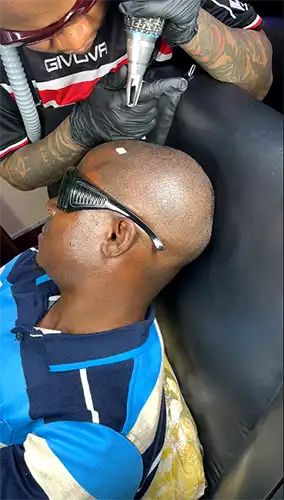Laser Micropigmentation (SMP) Correction
Laser micropigmentation (SMP) correction is a specialized process used to modify, lighten, or remove existing SMP—a cosmetic tattooing method typically applied to replicate the appearance of hair follicles on the scalp or enhance features like the definition of eyebrows or areolas. The correction process is complex and must be tailored to the individual’s skin characteristics, the depth and type of pigment used, and the desired aesthetic outcome. Below is a comprehensive overview of SMP correction through laser treatments.

Overview of SMP and Reasons for Correction
Scalp Micropigmentation (SMP)
SMP is primarily employed to create the illusion of a fuller head of hair by depositing tiny dots of pigment into the scalp’s epidermal layer. It is also used in other cosmetic applications such as recreating the appearance of a natural areola after mastectomy or camouflaging scars. However, several factors may necessitate correction, including:
- Design or Color Dissatisfaction: When the pigmentation or design does not meet expectations.
- Technique and Application Errors: Inconsistent dot placement or pigment saturation can lead to an unnatural appearance.
- Aging or Fading: Over time, pigment fading or color shifts may occur, making the initial SMP less effective.
- Lifestyle and Aesthetic Changes: Clients sometimes opt for a change in appearance as personal style or hair patterns evolve.
Why You Might Need SMP Correction
SMP is a form of cosmetic tattooing, and like all tattoos, it can fade, blur, or even be applied incorrectly. Here are some common reasons our clients seek laser scalp micropigmentation correction:
- Uneven or blotchy pigment
- Pigment color has changed (e.g., turned blue/green)
- Incorrect hairline shape or placement
- Desire for a new style or full pigment removal
- Poor quality work from inexperienced artists
No matter the reason, our experienced laser technicians are here to help correct and enhance your SMP with precision and care.
How Laser SMP Correction Works
We use advanced Q-Switched Nd:YAG and Picosecond laser technology, specifically designed for safe and effective tattoo and pigment removal. Here’s what the process looks like:
- Consultation & Skin Analysis: Every journey begins with a one-on-one consultation. We assess your skin type, pigment color, SMP depth, and design goals to create a customized correction plan.
- Targeted Laser Treatment: Our laser targets the pigment particles embedded in the scalp, breaking them into tiny fragments. These are naturally flushed out by your immune system over time.
- Gradual Fading or Full Removal: Depending on your desired outcome, we can lighten the pigment to allow for a better re-application, or completely remove it over several sessions.
- Healing & Aftercare Support: We provide detailed aftercare instructions and continuous support to ensure proper healing and long-lasting results.
Laser-Based SMP Correction: Mechanism and Techniques
Mechanism of Laser Correction
Laser removal for SMP works on the principle of selective photothermolysis—where the laser light targets the pigment particles without significantly damaging the surrounding tissue. The laser energy causes the pigment to break into smaller fragments, which are then gradually eliminated by the body’s immune system via phagocytosis. Key factors influencing success include:
- Wavelength Specificity: Different laser wavelengths are chosen based on the pigment’s color and depth. For instance, Q-switched Nd:YAG lasers are frequently used because of their ability to treat dark pigments effectively.
- Pulse Duration: Q-switched lasers emit high-energy pulses in very short durations. This minimizes collateral thermal damage and helps shatter the pigment particles more precisely.
- Picosecond Technology: Newer picosecond lasers deliver energy even more rapidly than Q-switched lasers. They can sometimes offer more efficient removal with potentially fewer side effects.
Laser Types Used in SMP Correction
- Q-Switched Lasers: The workhorse for tattoo and SMP correction, these lasers (often operating at 1064 nm for darker pigments) are effective in targeting dense pigment deposits while reducing the risk of scarring.
- Picosecond Lasers: These lasers offer ultra-short pulse durations that can more precisely fragment pigment particles, making them a favorable option in some cases for challenging SMP corrections.
- Combination Approaches: In some instances, a combination of wavelengths might be employed to address multi-colored pigments or to adjust for variation in pigment depth.
The Treatment Process
- Initial Consultation and Evaluation: A thorough examination is essential. Our specialist assesses the pigment type, depth of application, skin type (Fitzpatrick scale), and any previous treatments.
- Test Patch: Before fully proceeding, a small test area is often treated to evaluate skin response and determine the ideal laser settings.
- Multiple Sessions: SMP correction is rarely a one-time procedure. Multiple sessions (often 4 to 8 or more, spaced 4–8 weeks apart) are typically required for gradual pigment breakdown while allowing the skin to heal between sessions.
- Monitoring and Adjustments: Regular follow-ups allow our practitioner to monitor pigment reduction, assess healing, and adjust laser parameters as needed.
Benefits of Choosing Our SMP Correction Services
- Performed by professional laser technicians
- Use of approved, medical-grade laser equipment
- Safe for all skin tones and types
- Customized treatment plans based on your goals
- Comfortable, low-downtime procedure
- Honest advice and expert aftercare
Correction vs. Full Removal:
- Correction: Lightens pigment so a new SMP treatment can be layered on top.
- Removal: Completely clears the area, returning your scalp to a natural tone.
Post-Treatment Care and Considerations
Aftercare Tips for Optimal Results
Taking care of your scalp after laser treatment is key to achieving the best results and preventing complications like irritation, infection, or uneven fading.
Do’s:
- Keep the area clean and dry (first 48 hours): Avoid washing your scalp for the first 1–2 days post-treatment. After that, use a gentle cleanser with lukewarm water.
- Apply a healing ointment (if advised): Your technician may recommend a fragrance-free moisturizer or a light ointment to soothe the skin.
- Protect the scalp from the sun: UV rays can interfere with healing and cause pigmentation issues. Wear a hat or apply SPF 30+ once the skin has healed.
- Stay hydrated & healthy: A strong immune system helps flush out pigment faster. Drink plenty of water and eat nutrient-rich foods to support healing.
- Follow the recommended session intervals: Allow at least 4–6 weeks between laser sessions for full healing and maximum pigment breakdown.
Don’ts:
- Don’t pick, scratch, or exfoliate the area: Let any scabs or flakes fall off naturally. Picking can lead to scarring or slow down the fading process.
- Don’t expose the area to excessive heat or sweat: Avoid saunas, steam rooms, intense workouts, or hot showers for at least 3–5 days.
- Don’t use harsh products on your scalp: Skip alcohol-based toners, scrubs, or anything with active ingredients like retinol or acids until your technician clears you.
- Don’t shave the treated area right away: Wait at least 4–5 days (or as directed) before shaving or trimming to avoid skin irritation.
If your scalp feels itchy or dry during healing, apply a thin layer of aloe vera gel or a recommended healing balm to soothe it — but only after the initial 48-hour window.
Potential Side Effects and Risks:
- Skin Discoloration: There is a risk of hypo- or hyperpigmentation, particularly in individuals with darker skin tones.
- Scarring: If not performed under optimal conditions, repeated laser treatments can potentially lead to scarring.
- Incomplete Removal: In some cases, residual pigment may remain, which might necessitate additional sessions or alternative correction techniques.
- Specialized Expertise Required: SMP correction is delicate; choosing a practitioner with experience in both SMP application and laser tattoo correction is key to achieving desirable results.
Is Laser SMP Correction Safe?
Yes — Laser Scalp Micropigmentation (SMP) Correction is safe when performed by a trained professional using the right laser technology.
Why It’s Safe:
- Non-invasive Treatment: Laser SMP correction does not involve cutting or surgery. It uses targeted light energy to break down pigment particles below the skin’s surface, making it low-risk with minimal downtime.
- No Damage to Hair Follicles: The laser targets only the pigment, leaving hair follicles and surrounding skin untouched — so it won’t affect your natural hair growth.
- Medical-Grade Technology: We use advanced Q-switched and picosecond lasers, trusted by professionals worldwide for tattoo and pigment removal. These lasers are FDA-approved and safe for use on the scalp.
- Suitable for All Skin Tones: Our lasers are adjustable for different skin types and pigment depths, reducing the risk of hyperpigmentation, scarring, or burns — especially in melanin-rich skin.
- Minimal Side Effects: You may experience temporary: Redness, Mild swelling, Light scabbing
– These usually clear within 24–48 hours with proper aftercare.
Alternatives and Complementary Approaches
While laser correction is a primary method for SMP modification, sometimes alternative approaches or complementary techniques might be considered:
- Microblading or Additional Pigmentation: In cases where only certain areas need correction, a touch-up with manual techniques might improve aesthetics.
- Camouflage Techniques: Sometimes, complete removal is not necessary; instead, the SMP can be lightened and then re-applied for a more natural finish.
- Combination of Laser Types: Depending on the individual’s response, the practitioner might combine laser modalities to optimize results.
Get In Touch
For more information on the list above and any other special services,please call or come in for free consultation
Testimonials
I am extremely happy with my new 'Safari' tattoo from Eric at Rebel Inks! The quality of the artwork is fantastic. Eric is a true professional and an amazing artist.
The preparation and design process was thorough and collaborative. He was very patient with my specific requests, including making sure all the elements, which hold personal meaning, were perfect.
The service was friendly and highly professional from start to finish. Despite the 8-hour session, Eric was a pleasant person to spend the time with.
The aftercare guidance and follow-up have been excellent and careful, which has made the healing process easy and better than expected.
I highly recommend Eric for anyone looking for a thoughtful, talented, and caring tattoo artist.
I recommend them 💯
I would definitely recommend if you’re thinking of getting a piercing!
The staff were super friendly, explained everything clearly, and made me feel so at ease. They answered all my nervous questions (and I had many questions),
They walked me through the whole process, gave detailed aftercare instructions, and even followed up afterward to check how I was healing 🫶
Clean, professional, and full of good vibes.
Would 100% recommend . Definitely making a second trip here.
This was the second tattoo I got and I wish I could have come to Eric for my first one! He gave me really great after-care directions for the tattoo as well as a little jar of his own Vaseline-type stuff to put over my tattoo while it was healing! He even put second skin over my tattoo so that I didn’t have to worry about it for the first few days. Now THAT’S good service. My first tattoo artist didn’t do none of that lol.
After the session Eric didn’t rush me and my friend out, he chatted with us and even when he found out I was an artist too— really encouraged me to keep creating and to find a community of artists to support me. I almost cried because I’ve had such a hard time with my own art the past couple of years, it meant so much to me to have a fellow very talented artist say that to me. 🤍🤍🤍
Eric you’re amazing, don’t ever stop creating and just know you’ve impacted lives all over the world!🫶🏻 thanks so much for everything!!
From the moment I walked in, Eric was professional, welcoming, and attentive. He made sure I was comfortable throughout, provided everything I needed, and explained every step of the process. The tattooing itself was unbelievably smooth - I genuinely felt no pain compared to my previous tattoos over the last 22 years.
Eric also gave me excellent aftercare guidance and products, and thanks to that, my tattoo healed beautifully. The attention to detail, precision, and shading are absolutely stunning. This is hands-down the best tattoo I've ever had, and I will be flying back to Nairobi for any future ink.
If you want incredible art, a professional experience, and a talented artist who truly cares about his clients, Rebel Ink is the place to go!
From start to finish, the service was exceptional. The piercer was professional, knowledgeable, and made me feel completely comfortable. The cleanliness of the place was above and beyond — everything was spotless and hygienic, which really put me at ease. Highly recommend for anyone considering a piercing!
Shout out to Eric😘
We ended up changing the jewelry three times to ensure I had the best fit and avoided any signs of rejection, and he always listened to my suggestions as a client, which I really appreciated. Now, three months in, my piercing is healing beautifully, with no sign of rejection. Highly recommend for anyone who values a piercer who cares about your comfort and healing journey!
What stood out the most was the aftercare Eric checked in with me even three weeks later to see how the tattoo was healing. That kind of follow-up shows how much he truly cares about his work and his clients.
I’m very satisfied and will definitely be coming back for my next piece. Highly recommend!
The piercing wasn't as painful as I had thought and the process was quick and satisfactory. I love it!!!
The piercing is healing well thanks to the aftercare instructions and follow-up. I would highly recommend Rebel Inks
Eric also did a belly button piercing for a friend, guiding her through the process, doing the piercing and then explaining the after care to her.
The shop is on the 3rd floor, with the entrance to the stairs near an alleyway on the left. The shop is perfect size, clean, and attractive looking. The mural is pretty dope.
Thank you for the amazing service! 🔥👅✨
I got piercibgs there and the process was really good. My biggest concern was hygiene but that wasn't an issue at all, they use new needles and they sanitize them.
The service itself was also welcoming.
I was informes of everything i needed to know beforehand.
10/10 would recommend!
Eric was so calm and patient with my almost 2 year old lady. It was such a clean and hygienic process. We will definitely be back for our second rounds of piercings and maybe even another tattoo!
They assess the area before any art and advise one accordingly. They also give one post clean up process and also do a check up after the body art projects. Overall, I loved my experience and I’m hooked. 👍
Will definitely come back next time I’m in town 🙂
He listened to what I actually wanted and made sure he could fit in the time before I flew back home.
The shop is clean & private and is easy enough to find.
Eric has even checked in a couple of times since to make sure all is good.
I would totally recommend Eric! I absolutely love my Elephants!
I had a very easy healing period and always follow up from Eric to check on my progress...I would highly recommend if you are a first timer because from my experience all went very well and attention to detail
Thank you for a good job and looking forward to send all my friends your way
And all the best with the new year 2025!
From the moment I walked in, the staff was super friendly and made me feel at ease. The studio had a clean, professional atmosphere, which immediately put me at ease. My piercer was incredibly skilled and explained every step of the process, ensuring I was comfortable the entire time. The piercing was quick and practically painless, and the aftercare instructions were clear and easy to follow. I can tell they really care about the health and safety of their clients.
Overall, a fantastic experience—I highly recommend Rebel Inks and Tattoos for anyone looking to get pierced or tattooed!
They do follow up after their services
Eric's Studio isn’t just a place to get a tattoo—it’s an experience. The combination of professionalism, artistic talent, and a welcoming environment makes it a standout destination for anyone considering a tattoo.
I highly recommend Eric’s Studio to both first-timers and seasoned tattoo enthusiasts. If you’re looking for a high-quality tattoo and an enjoyable experience, this is the place to go.
I would definitely recommend their services again and again
Thank you Rebel Ink
My piercings are healing ❤️🩹 well
I would 💯 recommend
I will definitely come back for more .
Two, all the equipments he used for the piercings were new and/or sterilised.
Three, the parlour itself was very clean and was up to par with the hygiene standards.
Four, Eric provided effective aftercare instructions, making sure I knew exactly how to take care of my new piercings and he kept in touch and continues to do so, to check on the healing progress.
I highly highly highly recommend this place!!!
Would definitely recommend them to friends and go back for other piercings
Not only was the piercing process smooth, but he also provided thorough aftercare instructions, making sure I knew exactly how to take care of my new piercings. What really impressed me was that he keeps in touch to check on how the healing is progressing – a sign of true care for his clients.
The shop maintains a high standard of hygiene, and the atmosphere is welcoming and comfortable, which really added to the positive experience. I highly recommend this place to anyone looking for a professional and caring experience. I’ll definitely be coming back for any future piercings!
My appreciation for the excellent customer service I received. The follow-ups were prompt, and I truly appreciated the gentleness and professionalism throughout. Thank you!"
"Looking for professional eyebrow microshading removal? Look no further!"
The customer care is top tier 👌🏾👌🏾.
Wonderful place to get tattoos and piercings. 💯💯
Eric goes ahead to follow up on his clients progress and gives good advice each time I reach out to him.
I would recommend Reble tattoos anytime.
Good job bro we really appreciate.
Ohh and the price is very fair.
The environment was clean , procedure was sterile and the jewelry used are of the best quality.
He followed up with me during the healing process, he educated me on what I needed to do for my aftercare.
Eric is confident, skilled , experienced and the best piercer. Highly recommend Rebel inks.✨
Definitely recommend!
Great experience.
Eric definitely know what he is doing .
I got exactly what I wanted 2 tiny tats on the same finger .
He was kind and patient throughout the session.
Healing process has been good .
Aftercare services were given and regular checkups on the healing process were done.
I would 💯recommend.
Eric gave me the best reception as it was my first time there,and made me trust him all the way. I appreciate good services.
There services are also affordable not to forget 😊.
He was also invested in the aftercare and would ensure I follow the do's and don'ts in taking care of the tattoo and ensuring proper healing and maximum ink retention.
Would highly recommend Rebel Inks Tattoos.
Rebel Inks Tattoo offer the best,affordable and quality tattoo removal services.If you have unwanted ink,choose Rebel Inks Tattoo,they're the best of the best and the professionalism is a top notch.They ensure you're free from unwanted ink with their Laser Tattoo Removal Technology...
I did a Laser Tattoo Removal with them and i can attest they're the best....
Kudos Eric...
I highly recommend.
It was a generally good experience with good hygiene during the piercing process and has been a smooth healing process.... 10/10
tips. Highly recommend 👍🏽
100% recommendable.
I was particularly impressed with Eric's attention to hygiene. He thoroughly cleaned the room before I entered, sanitized all of the equipment he would be using, and changed gloves between each ear. This level of cleanliness gave me great confidence in his professionalism.
Eric's commitment to customer service did not end on the day of the piercing. He followed up with me regularly throughout the healing process to ensure that I was following the aftercare instructions and that my earlobes were healing properly.
I highly recommend Rebel Inks to anyone in Nairobi who is considering getting a piercing. Eric is a highly skilled and experienced piercer who takes great pride in his work.
So I Check all the boxes below and more:
Customer Care: ✔️
Professionalism : ✔️
Cleanliness ✔️
Price: ✔️
After care service ✔️
Thanks and good job, Eric
The place is neat and clean and the equipments he used were also fine standards. Really appreciate his following up with me on the healing 🤗
I WOULD HIGHLY RECOMMEND THEIR SERVICES to everyone. Actually what you see on their website is EXACTLY what you will get. Keep up the good work Rebel inks Tattoos.
The infection is now gone. I would definitely recommend!
Can recommend this place totally and would go back there anytime!
Thanks!
OUR LOCATION
Areas We Serve
NAIROBI
KIAMBU
KAJIADO
MACHAKOS





































































































































































































































